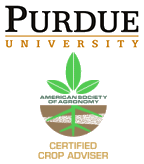
Proceedings 2008
Indiana Certified Crop Adviser Conference
When you need an Aerial Applicator, whom do you call?
Aerial application of pesticides, including fungicides, often may be the most efficient and economical means of treating a rapidly spreading pest in any monocultural system. The circumstances that favor use of aerial application versus a ground application will be discussed as well as the unique operating environment in which an aerial applicator must function effectively. Useful selection criteria that may be used to identify quality aerial application firms will be also discussed in detail.
Paul (Mac) HortonDirector
Clemson Institute for Economic & Community Development
mhorton@clemson.edu
Dr. Mac Horton is a native of Charleston, South Carolina. He received his BS ( Zoology’69) and his MS (Entomology’73) from Clemson University and his PhD (Entomology ’81) from Auburn University.. Mac joined the Clemson Entomology Department in 1975 and spent most of his career there as a faculty member and extension Specialist. For much of this time Mac was the extension pesticide coordinator for SC as well as the primary extension specialist working with the South Carolina Agricultural Aviation Association to improve safety and application efficiency. He conducted Operation SAFE fly-in clinics in SC, GA and FL. He also served as the Interim Program Leader for Pesticide Education in Washington for 1986 and 1987. Mac became the Chair of Clemson’s Entomology department in 1997. He served as the Assistant Director of Clemson Extension and Research from 1999 until 2002 and then was named the Director of the Clemson Institute for Economic and Community Development and also the Sandhill Research and Education Center in Columbia, SC. The Sandhill Center is one of seven off-campus centers in South Carolina operated by Clemson. It is located on 600 acres of land northeast of Columbia, South Carolina. The facility served primarily for agricultural research over the past 75 years. Because of its’ mid-state and now mostly urban location, in 2002 it was charged to provide leadership toward two of the five Clemson public service program areas: Environmental Conservation and Economic and Community Development. Mac’s wife, Elaine is a 1977 graduate of Clemson. They have one child, Alison who received her BS and PhD from Clemson. Mac’s father is also a Clemson Alumnus so it is no surprise that Mac hopes his two grandchildren, will also choose Clemson for their college education.